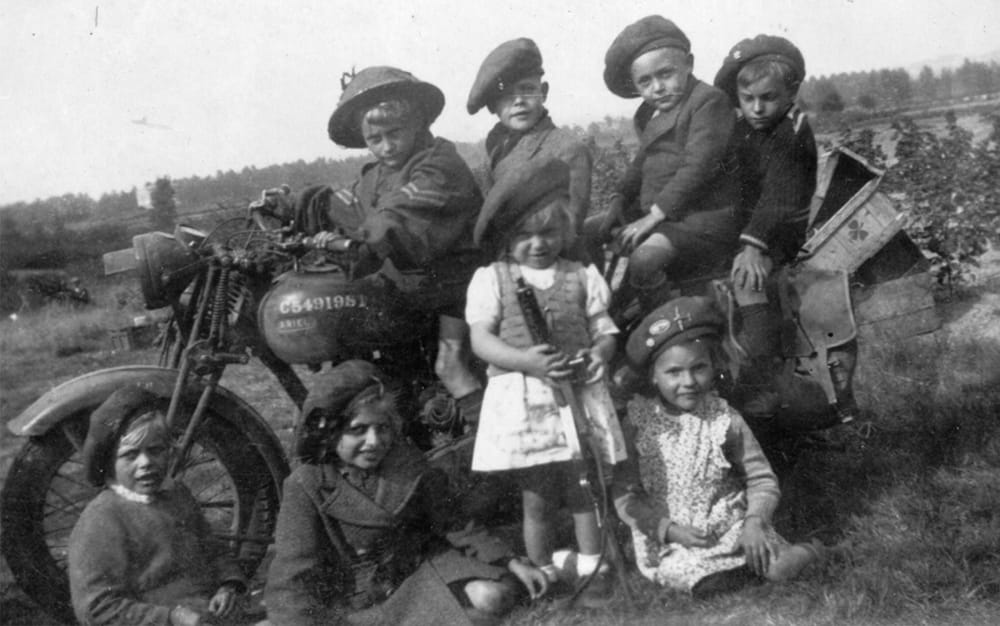Many years ago I had talked with Roland Pike about this question, he told me that the large pipe diameter was a carryover because sometimes factorys do not like to make changes (hard headed). He told me the story that Ariel was complaining that there twins were not making the power that BSA were making, when they were tested Ariel (twins) were not making the same power and it came down to the BSAs had smaller diameter pipes, demonstrated reason to Ariel. Ariel said thanks did not change diameter but no longer complaned."Side valves had big pipes that the way it is". My son and I are building a B50 roadracer and we are testing a steped diameter exhaust small to large and length due to valve overlap picking up more midrange power. Increase so far is impressive. worked for months to get length and diameter correct. This race season we will see what happens.
email (option): millcrocfarm@gmail.com
On a website that I cant retrace anymore I read about Roland Pike and a tale about tuning he and others did on a BSA Goldstar.
By accident they found out that a step in the inlet made for a increase in power.
So new Goldstars where delivered with a smaller inlet in the head compared to the carb size.
More then one owner, when finding out that the carb was bigger then the inlet, enlarged the inlet in the head and lost the gain power again.
The article also gave information about this 'step' in the inlet, in fact a venturi. see drawing I made below.

Apparently the idea was the step improved 'swirl' for better cylinder filling and air/fuel mixing...I'm struggling to absorb the information on this subject at the 'deeper' level beyond 'ball park figures'....The flow through the inlet, the engine itself and the exhaust system are all interlinked, affected by and dependent on each other...
I know I'm going to have to read more and think more if I'm to get past the basics to a reasonable level of understanding...
It's one of the things I like about tuning...To rebuild a standard engine you follow the laid down specifications and procedures and you can successfully get a bike running without really understanding how it works, only how it goes together....Tuning requires knowledge of the theories governing how the engine works if improvements are to be found beyond the obvious alterations like compression ratios and the normal cam changes....
Although I've had my moments with power outputs achieved, I have nothing but admiration for the designers and tuners who reached a point far beyond anything I have managed so far or am ever likely to!!....Ian
email (option): ian@wright52.plus.com
I can certainly testify that my race pipe is too short. It’s about 800mm long, the standard pipe is another 150mm roughly before the muffler. I realised this when the engine went back in the road bike. The tale below explains!
At this year’s, 2021, Speed Week I ran my road engine again as the short stroke is still it ready, it won’t make 2022 either, but that’s another story. Anyway the engine has my first version of a special head, which allowed 65-2442 inlet to be used, about 11.5 mm lift. For various reasons I didn’t finish the setup until the day of packing for the trip and it appeared to be very rich and hesitant mid range but ok(ish) at the top end, just reving offload. At the meeting the best I could manage was 73mph, down on previous setup by 20mph but that was the top in 3rd or 4th and it felt like the issue was carby setup. I’ve been hampered in doing much over the year with lockdowns, as I only have my parking space and cage in the apartment so have to use a communal workshop. Anyway I got as far as finding lots of reversion (pulses back through the carby to the extent that the fuel overflowed the float chamber, it’s a Mikuni VM36) and then preparing some valve caps to go with some beehive springs to give about 130lbs seat pressure and trying a pulse-jet plug insert. In Dec I put the engine back in the road bike as I wanted to go on a bike run!! I’ve only one working engine! After some teething troubles with fouled plugs (the pulse-jet came with an 8 grade NGK)I’ve found the setup is pretty good. Only one bad spot just of the stop only annoying when cruising on a level road. The run out to Malmsbury about 130km for a post Christmas BSA meeting was the first real test and I’d got water in the maggy the day before so was later than even I’d planned so I took the Calder Freeway once I was out of Melbourne, that’s a 110km/h road which I’d normally avoid at all costs. However felt I had no choice and much to my amazement I was easily able (hills excepted) to keep up with traffic and overtake a few, ie easily keep at 65-70 indicated. At one point I thought I’d wind it open and the needle as around 80mph but I had a scary moment of weave / slow tank slap requiring to be brave at keep throttle open and gradually quell the wobble and gradually back off. But I was pleasantly surprised by the top end speed, and that’s down to the pipe length at least in the main.
email (option): dickie.bobbie@hotmail.co.uk
